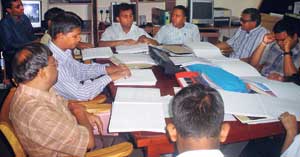In July 2009 as part of their celebrations of Louis Braille’s 200th birth anniversary the Special Needs Resource Centre of the University of Peradeniya held a six-day residential training workshop on the Braille system of music notation as applied to Western Music, for the benefit of vision impaired teachers of music throughout the country.
This workshop proved to be highly beneficial to the participants, and there were repeated requests for a follow-up course the next year. And so last month saw the arrival of ten participants for the Braille music notation workshop at the campus grounds of the University of Peradeniya. Wimal Weerakkody, Professor of Classical Languages at the Faculty of Arts headed the programme and guided the participants on a unique learning experience.
Braille music notation was developed by Louis Braille, the inventor of the Braille system itself, to enable blind musicians to read and write music efficiently. It has enabled thousands of vision- impaired musicians not only to learn the compositions of the great masters, but also to express their own musical ideas in original compositions. Professor Weerakkody recognised that in recent times the knowledge of Braille in general, and of Braille music in particular, has shown a marked decline in Sri Lanka.
“Although many blind and vision impaired persons in Sri Lanka have taken to the teaching of music as a career they are hampered by their inability to handle music notation,” he said.
Prof. Weerakkody believes that the need for such knowledge is on the rise, as even the Eastern Music syllabi for the G.C.E’s now contain a compulsory Western Music component.
The first workshop held last year covered the basics of western music notation in Braille. This year’s programme included a recap of last year’s topics as well as more advanced work. The purpose of the second workshop was to ensure progress in the field and therefore only the participants of last year’s workshop were accepted into the programme. “This is not an easy task for us,” Prof. Weerakkody reiterates, pointing out that it is a common misconception that musical performances are somehow easier for blind or visually impaired people. Reading Braille requires the use of one hand, which cannot be used to play an instrument simultaneously.
Braille notation must therefore be memorised before practical application on an instrument – a task nearly impossible for a sighted performer. Learning at the workshop was facilitated by various textbooks on Braille music notation, copies of which were made available to each participant, and tactile diagrams. “The materials are very expensive to produce,” commented Prof. Weerakkody, who said this would not have been possible without sponsors.”
Last year's programme was sponsored by the American Embassy, while this year’s programme was supported by the Ministry of Higher Education, CBM (Christoffel-blindenmission now Christian Blind Mission) Sri Lanka – a century old Christian organisation working to improve rehabilitation opportunities for people with disabilities around the globe – and several private donors. Dr. Saman Senanayake, consultant ophthalmologist at the Kandy General Hospital, who takes a personal interest in the rehabilitation and protection of rights of the visually impaired, provided immense support in locating and contacting these sponsors,” he said.
Although Prof. Weerakkody, being modest by nature, did not set out to achieve a monumental or life-altering goal, the results of his thoughtfulness cannot be but gratifying. As of two years ago, there were but two or three Sri Lankans capable of reading Braille music notation.
Among these were the professor himself and the late Mr. Alexander who was the well-known and much- loved resident organist at the Trinity College Chapel in Kandy. Since the commencement of the workshop, this number has grown to nearly 15 people. The magnitude of the achievement is not very clear until one realises that the participants of the workshop are all music teachers, who when in their respective schools and institutions will pass this knowledge on to many more blind and vision-impaired students.
A mere six days of work can almost completely utilise ten teachers of Braille music notation, and the work they are able to complete in the same amount of time increases exponentially. Prof. Weerakkody may have set out simply to complete a small task, but what he has achieved has the potential to be of great significance in terms of Western Music in Sri Lanka. |


